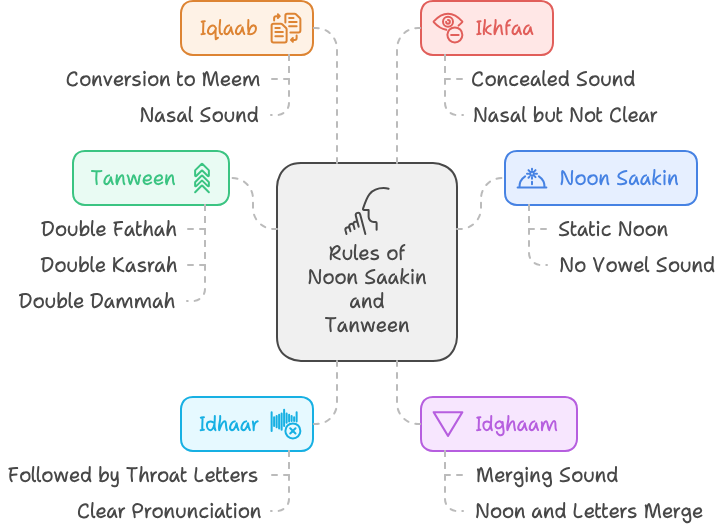Rules of Noon Saakin and Tanween
Introduction:
In Quranic recitation, the rules governing Noon Saakin (ن) and Tanween (ـً ـٍ ـٌ) are fundamental to proper tajweed. These rules ensure correct pronunciation and help maintain the integrity of the Quranic text. There are four main rules that apply to Noon Saakin and Tanween: Izhaar, Idghaam, Iqlaab, and Ikhfaa.

Overview of the Rules:
| Rule | Meaning | When Applied |
|---|---|---|
| Izhaar (إظهار) | To make clear | When followed by throat letters |
| Idghaam (إدغام) | To merge | When followed by certain letters (ي ر م ل و ن) |
| Iqlaab (إقلاب) | To convert | When followed by ب (baa) |
| Ikhfaa (إخفاء) | To hide | When followed by the remaining letters |
Detailed Explanation of Each Rule:
1. Izhaar (إظهار)
Izhaar means to pronounce the noon saakin or tanween clearly without any غنة (ghunnah, nasalization). This occurs when noon saakin or tanween is followed by any of the six throat letters: أ، هـ، ع، ح، غ، خ
مِنْ خَيْرٍ
Transliteration: min khayrin
Here, the noon saakin in “min” is pronounced clearly because it’s followed by خ (khaa).
2. Idghaam (إدغام)
Idghaam involves merging the noon saakin or tanween into the following letter. It’s divided into two types:
- Idghaam with ghunnah: When followed by ي، ن، م، و
- Idghaam without ghunnah: When followed by ل، ر
مَن يَعْمَلْ
Transliteration: may ya’mal (merging with ghunnah)
مِن رَّبِّهِمْ
Transliteration: mir rabbihim (merging without ghunnah)
3. Iqlaab (إقلاب)
Iqlaab means to convert the noon saakin or tanween into a meem (م) sound when followed by the letter baa (ب). It’s pronounced with ghunnah.
مِنْ بَعْدِ
Transliteration: mim ba’di
4. Ikhfaa (إخفاء)
Ikhfaa means to hide the noon saakin or tanween sound. It’s a state between Izhaar and Idghaam, pronounced with ghunnah. This rule applies when noon saakin or tanween is followed by any of the remaining 15 letters not covered by the previous rules.
مَن كَانَ
Transliteration: man kaana
Practical Application and Examples:
To practice these rules, try reciting the following verses, paying close attention to the noon saakin and tanween:
| Rule | Example | Explanation |
|---|---|---|
| Izhaar | وَالْعَصْرِ إِنَّ الْإِنسَانَ لَفِي خُسْرٍ | The tanween in “khusrin” is pronounced clearly because it’s followed by the throat letter خ (khaa). |
| Idghaam | فَمَن يَعْمَلْ مِثْقَالَ ذَرَّةٍ خَيْرًا يَرَهُ | The noon in “man” merges into the following yaa with ghunnah. |
| Iqlaab | لَيُنبَذَنَّ فِي الْحُطَمَةِ | The noon in “layunbadhanna” is converted to a meem sound. |
| Ikhfaa | مِن تَحْتِهَا الْأَنْهَارُ | The noon in “min” is hidden (pronounced with a nasal sound) because it’s followed by taa. |
Conclusion:
Mastering the rules of Noon Saakin and Tanween is crucial for proper Quranic recitation. Regular practice and listening to proficient reciters will help in applying these rules correctly. Remember, the goal is not just to memorize the rules, but to implement them naturally in your recitation, enhancing the beauty and accuracy of the Quranic words.





